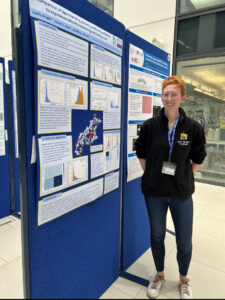Tuesday 20th January 2026 from 19:00 for 19:30
Abingdon United Football Club (Northcourt Rd, OX14 1PL, Abingdon)
 Many people remember the bovine spongiform encephalopathy (BSE) epidemic which terrorised the population and decimated the British beef industry in the early 1990s, but few have heard of the causative agent. Prions are a unique pathogen: a transmissible misfolding protein which causes dementia. They are the only infectious pathogen which do not have their own genetic material (unlike viruses and bacteria) and the healthy form of the protein exists naturally in the human body. Although rare, sporadic and genetic forms of prion disease still affect the population today, and a cure has remained elusive. This is due to the many mysteries which still surround the prion protein: where, why, and how do prions start replicating in the brain? This talk will cover the mechanisms of these diseases, work on uncovering the secrets of prion propagation, and why prions are important in the fight against Alzheimer’s and other neurodegenerative diseases.
Many people remember the bovine spongiform encephalopathy (BSE) epidemic which terrorised the population and decimated the British beef industry in the early 1990s, but few have heard of the causative agent. Prions are a unique pathogen: a transmissible misfolding protein which causes dementia. They are the only infectious pathogen which do not have their own genetic material (unlike viruses and bacteria) and the healthy form of the protein exists naturally in the human body. Although rare, sporadic and genetic forms of prion disease still affect the population today, and a cure has remained elusive. This is due to the many mysteries which still surround the prion protein: where, why, and how do prions start replicating in the brain? This talk will cover the mechanisms of these diseases, work on uncovering the secrets of prion propagation, and why prions are important in the fight against Alzheimer’s and other neurodegenerative diseases.
Speaker: Caitlin Wright
 Caitlin is currently a doctoral student at the MRC Prion Unit, which is part of University College London. Her interest in science stems back to her teenage years, when she was an ATOM ambassador for her school in Abingdon. After learning about prions around this time, Caitlin followed her interests, leading her to complete her undergraduate master’s degree at the University of Manchester, studying the links between oxidative stress and yeast prions. Caitlin’s work now focuses on finding the cellular cofactors required for propagation of sporadic and variant Creutzfeldt Jakob Disease prions.
Caitlin is currently a doctoral student at the MRC Prion Unit, which is part of University College London. Her interest in science stems back to her teenage years, when she was an ATOM ambassador for her school in Abingdon. After learning about prions around this time, Caitlin followed her interests, leading her to complete her undergraduate master’s degree at the University of Manchester, studying the links between oxidative stress and yeast prions. Caitlin’s work now focuses on finding the cellular cofactors required for propagation of sporadic and variant Creutzfeldt Jakob Disease prions.
 Robin is an expert in satellite imaging, having won the Remote Sensing and Photogrammetry Society’s PhD Prize for his thesis in 2014. Afterwards he worked in academia but is now a freelance geospatial software engineer, working for clients ranging from small community groups to multi-national corporations to store, process and visualise geographic data such as satellite images and maps.
Robin is an expert in satellite imaging, having won the Remote Sensing and Photogrammetry Society’s PhD Prize for his thesis in 2014. Afterwards he worked in academia but is now a freelance geospatial software engineer, working for clients ranging from small community groups to multi-national corporations to store, process and visualise geographic data such as satellite images and maps.

